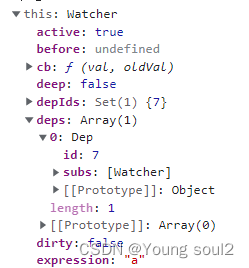由于我在从源码看vue(v2.7.10)的computed的实现原理中详细的讲解过computed的实现,本篇跟computed的原理类似。我就带大家简单分析一下。
添加依赖
代码如下:
<template>
<div>
{{a}}
<button @click="addModule">新增</button>
</div>
</template>
<script>
export default {
name: "TestWebpackTest",
mounted() {
console.log(this);
},
data() {
return {
num: 1,
a:2
};
},
watch:{
a: function (val, oldVal) {
console.log(val, oldVal)
},
},
methods: {
addModule() {
this.a++;
}
}
};
</script>
<style lang="scss">
div {
.test {
width: 10px;
height: 15px;
background-color: blue;
}
}
</style>
初始化watch方法发生在initState(vm)方法中,该方法执行initWatch方法:
function initState(vm) {
var opts = vm.$options;
...
if (opts.watch && opts.watch !== nativeWatch) {
initWatch(vm, opts.watch);
}
}
...
function initWatch(vm, watch) {
for (var key in watch) {
var handler = watch[key];
if (isArray(handler)) {
for (var i = 0; i < handler.length; i++) {
createWatcher(vm, key, handler[i]);
}
}
else {
createWatcher(vm, key, handler);
}
}
}
...
function createWatcher(vm, expOrFn, handler, options) {
if (isPlainObject(handler)) {
options = handler;
handler = handler.handler;
}
if (typeof handler === 'string') {
handler = vm[handler];
}
return vm.$watch(expOrFn, handler, options);
}
initWatch函数会判断当前的watch方法a是不是个数组,不是数组执行else的 createWatcher(vm, key, handler)方法。主要执行vm.$watch(expOrFn, handler, options)方法:
Vue.prototype.$watch = function (expOrFn, cb, options) {
var vm = this;
...
options = options || {};
options.user = true;
var watcher = new Watcher(vm, expOrFn, cb, options);
...
return function unwatchFn() {
watcher.teardown();
};
};
$watch方法主要是实例化了一个观察者Watcher:
function Watcher(vm, expOrFn, cb, options, isRenderWatcher) {
...
this.dirty = this.lazy; // for lazy watchers
this.deps = [];
this.newDeps = [];
...
// expOrFn = 'a'
if (isFunction(expOrFn)) {
this.getter = expOrFn;
}
else {
this.getter = parsePath(expOrFn);
...
}
this.value = this.lazy ? undefined : this.get();
}
由于expOrFn是字符串’a’,所以会执行 parsePath(expOrFn)方法:
function parsePath(path) {
...
// ['a']
var segments = path.split('.');
return function (obj) {
for (var i = 0; i < segments.length; i++) {
if (!obj)
return;
obj = obj[segments[i]];
}
return obj;
};
}
该方法返回一个函数,并赋值给watcher实例的getter方法。此时执行完this.getter = parsePath(expOrFn)方法,继续执行this.get()方法:
Watcher.prototype.get = function () {
pushTarget(this);
var value;
var vm = this.vm;
try {
value = this.getter.call(vm, vm);
}
catch (e) {
...
}
finally {
...
popTarget();
this.cleanupDeps();
}
return value;
};
该方法执行pushTarget将Dep.target设置为当前观察者(watcher),然后执行 this.getter.call(vm, vm)方法,由于getter方法是parsePath(expOrFn)方法的返回函数:
// obj = 'vm' segments = ['a']
function (obj) {
for (var i = 0; i < segments.length; i++) {
if (!obj)
return;
obj = obj[segments[i]];
}
return obj;
}
这里可以看出遍历watch方法的key值,这里是’a’,然后去当前的vm实例中获取该变量,触发该变量的getter方法从而建立该观察者和该变量之间的关系。

当前的watch方法a有一个deps放的就是发布者,该发布者的更新要触发订阅者,所以subs里面放的是watch方法a的watcher。
触发依赖
触发依赖的过程很简单,当数据改变时会触发变量的setter方法。会获取该变量的订阅者,并执行订阅者中的update方法:
Dep.prototype.notify = function (info) {
// stabilize the subscriber list first
var subs = this.subs.slice();
...
for (var i = 0, l = subs.length; i < l; i++) {
if (info) {
var sub = subs[i];
sub.onTrigger &&
sub.onTrigger(__assign({ effect: subs[i] }, info));
}
subs[i].update();
}
};
Watcher.prototype.update = function () {
// this.lazy = false
if (this.lazy) {
this.dirty = true;
}
...
else {
queueWatcher(this);
}
};
最后会执行queueWatcher(this)方法,接下来一系列的过程就是异步执行watcher.run()方法:
Watcher.prototype.run = function () {
if (this.active) {
var value = this.get();
if (value !== this.value ||
// Deep watchers and watchers on Object/Arrays should fire even
// when the value is the same, because the value may
// have mutated.
isObject(value) ||
this.deep) {
// set new value
var oldValue = this.value;
this.value = value;
if (this.user) {
var info = "callback for watcher \"".concat(this.expression, "\"");
// this.cb是watch方法a的函数
invokeWithErrorHandling(this.cb, this.vm, [value, oldValue], this.vm, info);
}
else {
this.cb.call(this.vm, value, oldValue);
}
}
}
};
该方法获取将新值和旧值放入invokeWithErrorHandling函数中:
function invokeWithErrorHandling(handler, context, args, vm, info) {
var res;
try {
res = args ? handler.apply(context, args) : handler.call(context);
if (res && !res._isVue && isPromise(res) && !res._handled) {
res.catch(function (e) { return handleError(e, vm, info + " (Promise/async)"); });
res._handled = true;
}
}
catch (e) {
handleError(e, vm, info);
}
return res;
}
该方法执行回调,至此watch方法a执行完毕。
总结
- 初始化执行initWatch(vm, opts.watch)方法创建watcher并定义了watcher的getter方法,随后触发getter方法去触发变量的getter方法建立变量和watcher相互之间的联系。
- 变量发生变化会触发变量的订阅者的update方法并执行run方法去获取最新的值,并通过执行订阅者的cb方法传入新旧值。
到此这篇关于Vue watch原理源码层深入讲解的文章就介绍到这了,更多相关Vue watch原理内容请搜索本站以前的文章或继续浏览下面的相关文章希望大家以后多多支持本站!